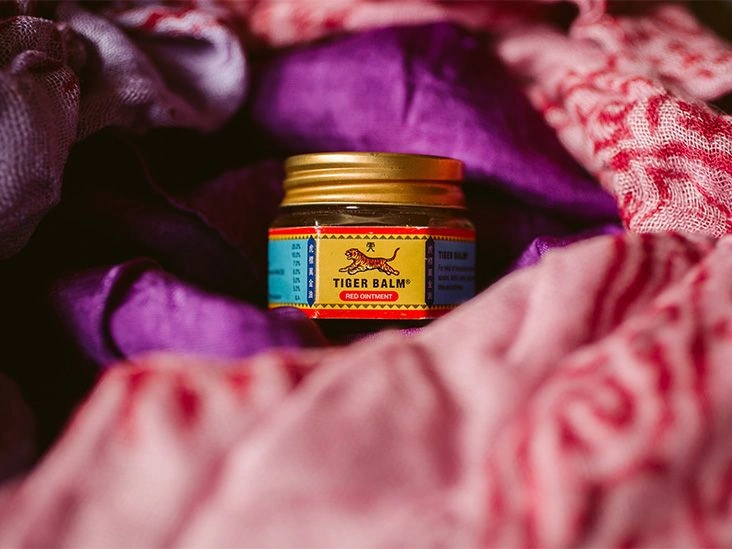Tiger Balm is a well-known topical product commonly used to ease pain. Its main components are camphor and menthol, which help reduce muscle and joint discomfort while producing a cooling feeling.
Tiger Balm has existed for more than 100 years. In the United States, the brand’s current lineup includes several over-the-counter (OTC) pain relief options such as:
- creams
- gels
- ointments
- patches
- sprays
- oils
Although Tiger Balm is promoted as a natural remedy, it’s important to recognize that these items are considered topical medications.
OTC products are not always individually evaluated or approved by the Food and Drug Administration (FDA), yet they must comply with specific FDA rules and standards to be legally sold.

What is Tiger Balm commonly used for?
In the United States, Tiger Balm products are aimed at relieving:
- arthritis and joint discomfort
- back pain
- neck and shoulder soreness
- muscle aches
- sprains and strains
While pain-relief formulations make up most of Tiger Balm’s global catalog, some products address other issues. Depending on where you are, you might find items intended for nasal congestion, itching, fever, and similar complaints.
What ingredients are in Tiger Balm?
Every Tiger Balm product contains a combination of herbal components. The precise formula and concentrations differ by country.
Many products include menthol, derived from mint oils, and camphor, obtained from the wood of certain tree species. These are labeled “active” because they deliver the therapeutic effects sought.
Other active ingredients in U.S. formulations can include methyl salicylate, sourced from wintergreen, and capsicum extract, which comes from chili peppers.
All remaining ingredients are classified as inactive. Typical inactive ingredients include:
- cajuput oil
- cassia oil
- clove oil
- dementholised mint oil
- eucalyptus oil
- paraffin petrolatum
What does the research indicate about Tiger Balm?
Scientific investigation into Tiger Balm itself is limited. Still, certain studies indicate that components commonly present in Tiger Balm can help ease different types of aches and pains.
Camphor, for instance, may aid recovery by increasing blood circulation to the area involved. It can also produce cooling and warming sensations that may soothe sore muscles.
Menthol and methyl salicylate can create a cooling or numbing effect that may relieve stiffness, while capsaicin functions by generating heat.
How should you apply Tiger Balm?
Topical Tiger Balm formulations are for external application only. Common areas people treat include:
- abdomen, hips, and lower back
- biceps, triceps, and forearms
- calves, hamstrings, and quadriceps
- neck, shoulders, and upper back
- wrists, elbows, and knees
The maker advises rubbing the product into the skin until it’s fully absorbed or, for patches, firmly adhered for best results. Patches can be worn for up to 8 hours, while other topicals may be used as often as four times per day.
Be sure to wash your hands thoroughly after application. Serious problems can happen if Tiger Balm contacts sensitive mucous membranes such as the:
- eyes
- nose
- mouth
- ears
- genitals
- anus
Avoid applying to irritated or broken skin, including:
- acne
- burns
- cuts
- scratches
- sores
- wounds
Hot baths or showers may increase skin sensitivity, so the manufacturer suggests waiting at least one hour before and at least 30 minutes after bathing to apply Tiger Balm to dry skin.
Using other thermal or cold treatments along with Tiger Balm raises the chance of irritation or injury, so it’s best to use only one method at a time. Do not cover the treated area with bandages or wrap it.
Are there side effects or risks with Tiger Balm?
When used as directed, Tiger Balm is unlikely to cause adverse effects.
However, it’s wise to try the product on a small skin patch — such as the inner elbow — to check for reactions. Watch for:
- burning or stinging sensations
- skin discoloration
- hives
- itching or irritation
- swelling
Stop using the product if you notice new or unusual symptoms within 24 hours of application.
Patches can’t be patch-tested in the same way, so closely observe them after placing and remove immediately if discomfort appears.
Rarely, anaphylaxis can occur. Seek emergency medical attention if you have trouble breathing or develop facial swelling.
When should you see a healthcare professional?
Tiger Balm is suggested for individuals aged 12 years and older.
Talk with a doctor or other healthcare professional before using any Tiger Balm item if you:
- are pregnant or breastfeeding
- have pain following surgery or a medical procedure
- experience persistent or worsening arthritis, knee, or joint pain
- are taking blood-thinning medications
Sometimes new or worsening symptoms can indicate an underlying condition needing medical evaluation. Contact a healthcare professional if you experience:
- bowel or bladder incontinence
- frequent leg cramps or muscle spasms
- numbness, tingling, or weakness in the feet or legs
- pain accompanied by swelling, discoloration, or restricted movement
- pain with fever and unexplained weight loss
- pain that persists for more than a week or returns after a few days
The bottom line
In the United States, Tiger Balm offers a selection of OTC pain-relief products. All formulations contain camphor or menthol, though other ingredients may differ across products.
Follow package instructions and discontinue use if you develop irritation or other unexpected symptoms.


















Leave a Reply
You must be logged in to post a comment.